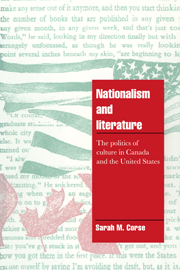Book contents
- Frontmatter
- Contents
- List of tables
- Acknowledgments
- 1 Introduction: cultural fields and literary use
- 2 Nation-building and the historical timing of a national literature in the United States
- 3 Nation-building and the historical timing of a national literature in Canada
- 4 The canonical novels: the politics of cultural nationalism
- 5 The literary prize winners: revision and renewal
- 6 The bestsellers: the economics of publishing and the convergence of popular taste
- 7 Literary meaning and cultural use
- Appendix A The canonical novels
- Appendix B The literary prize winners (1978–1987)
- Appendix C The bestsellers (1978–1987)
- Appendix D Coding sheet
- Appendix E Generic categories
- References
- Index
1 - Introduction: cultural fields and literary use
Published online by Cambridge University Press: 11 May 2010
- Frontmatter
- Contents
- List of tables
- Acknowledgments
- 1 Introduction: cultural fields and literary use
- 2 Nation-building and the historical timing of a national literature in the United States
- 3 Nation-building and the historical timing of a national literature in Canada
- 4 The canonical novels: the politics of cultural nationalism
- 5 The literary prize winners: revision and renewal
- 6 The bestsellers: the economics of publishing and the convergence of popular taste
- 7 Literary meaning and cultural use
- Appendix A The canonical novels
- Appendix B The literary prize winners (1978–1987)
- Appendix C The bestsellers (1978–1987)
- Appendix D Coding sheet
- Appendix E Generic categories
- References
- Index
Summary
National literatures are an assumption of modern cultural landscapes. In countries around the world schoolchildren in state-mandated courses read the “Great Works” of their nation. Universities offer literature courses in a smorgasbord of national units: course catalogues list classes such as “Russian Masterpieces,” “The Brazilian Novel,” and “Major American Authors.” The style, themes, and narratives of each nation's literary canon, the pantheon of most valorized and legitimated texts, are analyzed and debated both in the scholarly literature and in more general social commentaries. Educated people are simply assumed to be conversant with their national canons. In the United States “everyone” is familiar with – even if one hasn't actually read – The Scarlet Letter and Moby Dick. National literatures are the cornerstones of national cultures.
National literature and national character
National literatures have traditionally been understood as reflections of the unique character and experiences of the nation. That is, it is felt that the unique experience of national life generates a national, collective consciousness, or in some formulations a “collective unconscious” marked by a distinctive set of values, tensions, myths, and psychological foci, that produces in turn a certain readily identifiable national character – the American cowboy or the French sophisticate, for example. This character, and the values, tensions, and myths from which it springs, is then discernible in indigenous cultural products. Thus the distinctiveness of a national literature is seen as the natural embodiment of the distinctive national character (e.g., Wolfenstein and Leites 1950; Goldmann 1964, 1970).
- Type
- Chapter
- Information
- Nationalism and LiteratureThe Politics of Culture in Canada and the United States, pp. 1 - 17Publisher: Cambridge University PressPrint publication year: 1996

